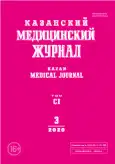Клиническая и лабораторная оценка эффективности применения комбинации антибактериальных средств при лечении хронического генерализованного пародонтита
- Авторы: Пури-захидан С.В.1
-
Учреждения:
- Азербайджанский медицинский университет
- Выпуск: Том 101, № 3 (2020)
- Страницы: 356-364
- Тип: Теоретическая и клиническая медицина
- URL: https://journals.rcsi.science/kazanmedj/article/view/34617
- DOI: https://doi.org/10.17816/KMJ2020-356
- ID: 34617
Цитировать
Аннотация
Цель. Определить эффективность применения комбинации метронидазола и ко-тримоксазола при лечении хронического генерализованного пародонтита.
Методы. В исследование были включены больные хроническим генерализованным пародонтитом лёгкой и средней степеней тяжести без сопутствующей патологии. Контингент больных был разделён на две сопоставимые по возрасту и тяжести заболевания пародонта группы. В первой группе больных в процессе лечебных мероприятий в пародонтальный карман вносили на турундах метронидазол, во второй группе — комбинацию ко-тримоксазола и метронидазола. При лабораторных исследованиях ротовой жидкости изучали уреолитическую и гликолитическую активность, содержание малонового диальдегида, диеновых конъюгатов, каталазы, лизоцима и секреторного иммуноглобулина A. Результаты исследования оценивали до и после проводимого лечения. В целом продолжительность лечения составила 12 дней.
Результаты. Комбинация антибактериальных препаратов ко-тримоксазола и метронидазола улучшала соотношение уреолитической и гликолитической активности, оказывала эффективное антиоксидантное влияние, которое проявлялось статистически значимым снижением содержания малонового диальдегида у пациентов с лёгкой степенью пародонтита на 32,8% (р <0,01), со средней степенью — на 36,6% (р <0,01), диеновых конъюгатов — на 25,0% (р <0,001) и 37,7% (р <0,001) при лёгкой и средней степенях пародонтита соответственно и повышением активности каталазы в 2,6 и 2,9 раза (р <0,001) соответственно при лёгкой и средней степенях заболевания. После лечения зарегистрировано повышение активности лизоцима на 11,3 и 17,6% (р <0,001) при лёгкой и средней степенях тяжести и уровня секреторного иммуноглобулина A при лёгкой степени пародонтита на 37,4% (р <0,001), при средней степени — на 53,2% (р <0,001). В первой группе при лёгкой степени заболевания количество секреторного иммуноглобулина A в ротовой жидкости увеличилось по сравнению с величиной до лечения на 35,8% (р <0,001), при средней степени пародонтита — на 45,6% (р <0,001), во второй группе — на 37,4% (р <0,001) и 53,2% (р <0,001) соответственно.
Вывод. Комбинированное лечение ко-тримоксазолом + метронидазолом способствует положительной динамике исследованных показателей, вызывает быстрое исчезновение симптомов, характерных для хронического генерализованного пародонтита; данную комбинацию препаратов рекомендовано включать в комплекс лечебных мероприятий при воспалительных заболеваниях пародонта.
Полный текст
Открыть статью на сайте журналаОб авторах
Сария Вагиф кызы Пури-захидан
Азербайджанский медицинский университет
Автор, ответственный за переписку.
Email: aga70@bk.ru
Азербайджан, г. Баку, Азербайджан
Список литературы
- Блашкова С.Л., Макарова Н.А. Протокол ведения больных хроническим генерализованным пародонтитом. Практич. мед. 2009; (1): 63–67.
- Халиуллина Г.Р., Блашкова С.Л., Макарова Н.А. Принципы патогенетической терапии больных хроническим генерализованным пародонтитом средней степени тяжести. Практич. мед. 2013; (4): 78–80.
- Bidra A.S., Shaqman M. Treatment planning and sequence for implant therapy in a young adult with generalized aggressive periodontitis. J. Oral. Implantol. 2012; 38 (4): 405–415. doi: 10.1563/AAID-JOI-D-10-00118.
- Заболевания пародонта. Под общей ред. Л.Ю. Ореховой. М. 2004; 201–247.
- Feres M., Soares G.M., Mendes J.A. et al. Metronidazole alone or with amoxicillin as adjuncts to non-surgical treatment of chronic periodontitis: a 1-year double-blinded, placebo-controlled, randomized clinical trial. J. Clin. Periodontol. 2012; 39: 1149–1158. doi: 10.1111/jcpe.12004.
- Горкунова А.Р. Изменение биохимических показателей в ротовой жидкости при вторичной адентии на фоне хронического генерализованного пародонтита. Научное обозрение. Мед. науки. 2015; (1): 136–137.
- Андреева Л.И., Кожемякин Л.А., Кишкун А.А. Модификация метода определения перекисей липидов в тесте с тиобарбитуровой кислотой. Лабораторное дело. 1988; (11): 41–43.
- Гаврилов В.Б., Гаврилова А.Р., Хмара Н.Ф. Изменение диеновых конъюгатов в плазме крови по УФ-поглощению гептановых и изопропанольных экстрактов. Лабораторное дело. 1988; (2): 60–64.
- Горячковский А.М. Клиническая биохимия. Одесса: Астропринт. 1998; 603 с.
- Дорофейчук В.Г. Определение активности лизоцима нефелометрическим методом. Лабораторное дело. 1968; (1): 28–30.
- Mancini G., Corbonard A.O., Heremdus J.F. Immunochemical quantitation of antigen by single radial immunodiffusion. Immunochemistry. 1965; 2 (3): 235–254.
- Храмов В.А., Гаврикова Л.М. Определение уреолитической и гликолитической активности ротовой жидкости человека. Стоматология. 1996; (3): 7–9.
- Фирсова И.В., Михальченко Д.В., Малюков А.В. Комплаентность пациента в стоматологической практике. Социология медицины. 2009; (1): 20–22.
Дополнительные файлы






